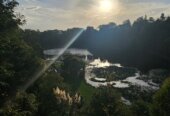
From front, Gabriel Roberts, Zachery Hartland and Sebastian Hoskin plant native trees along a streambank.
Karapiro School students have been hands-on at a nearby farm learning about biodiversity, riparian planting and how to keep waterways clean as part of the Trees for Survival programme.
The environmental education initiative as part of the Enviroschools programme teaches children how to restore natural habitats through native tree planting, helping landowners to revegetate erosion-prone land, improve stream quality and increase biodiversity.
Students worked on the Blunt family farm on Karapiro Road and some of the Year 4, 5 and 6 students will revisit the area over the next few years to continue planting and see how their work has helped change the landscape for the better.
“The kids can actually see that they’re making a difference,” said Alex Daniel, an Enviroschools facilitator from Waikato Regional Council who worked with the Karapiro School students on the Blunt family farm recently.

Sophie Lea with a mayfly she found as part of a biodiversity study.
She said 10 schools in Waipa, including five in Cambridge, were taking part in the programme.
“The aim is to get riparian planting and look after waterways, and we do a stream study at the same time to understand the invertebrates and the different characteristics of a stream,” she said. “At the end we ask, what can we do to make it better? And usually the answer is to plant trees to stop run off and erosion. It’s all about working with community farms, learning about the science behind it and keeping the water clean.”
“This term we’ve been learning all about our environment and looking after our environment,” said Karapiro’s environmental teacher Harriet Embling. “And it’s great that a lot of this (tree planting) work is along the main road, so they’ll be able to see them and watch them grow.”
The students grew the trees themselves in the school’s ‘Trees for Survival’ nursery.

Students examined a range of invertebrates during the stream study.
Principal Tina-Maree Thatcher said the students had enjoyed following the trees through the process of seedlings to their new home on the farm, and the school was grateful to the Blunt family for their involvement.
“Our students were able to work with a wide variety of different species of plants and learned about what plants and trees need over their life cycle to survive. A key aspect of this learning is respect for the natural environment and participation towards building a sustainable community,” said Thatcher.
The students themselves said the best part of all was playing in the mud – as in planting trees, and exploring the ‘creepy-crawlies’ of the environment.








